Shrubs with blue flowers add a sense of refinement and tranquillity to any garden setting. Stunning focus points can be made with shrubs that have vivid blue, teal, indigo, and aqua-blue flowers.
The deep green, lush foliage of the bushes, together with other plants and flower gardens, is complemented by the distinctive blue blooms. In this post, we go over our picks in greater detail—complete with pictures and descriptions!
1. Blue Rhododendron

Scientific Name: Rhododendron
Plant Type: Shrub
Plant Size: 2 to 3 feet
Sun Exposure: Partial sun
The classic plant with blue flowers is called the Blue Rhododendron, sometimes known as the “Blue Tit” Rhododendron. The tiny, dark leaves of the rhododendron are an evergreen that can be used year-round as a hedge or border in yards. Every season, the Blue Rhododendron requires careful trimming due to its thick and fast-spreading nature.
The blue rhododendron’s flowers are grouped in clusters of three to five. The trumpet-shaped flowers typically start as a light bluey-purple colour before deepening into a deeper shade of blue.
2. Chaste Tree

Scientific Name: Vitex agnus-castus
Plant Type: Shrub
Plant Size: 3 to 16 feet
Sun Exposure: Full sun
The Chaste Tree bears a resemblance to a lilac shrub, yet it thrives in regions with warmer summers. It features cone-shaped blooms and long, spiky foliage. The blooms come in three colours: white, pink, or purplish-blue. But because they don’t grow quite as densely, the individual blossoms are less like those of lilacs.
Chaste trees can be used as a border element in a yard or as a shrub on their own. Among other things, they are occasionally considered for medical purposes to treat premenstrual syndrome. The idea that a chaste tree is a useful medication or health product, however, is not supported by any solid research.
3. Lily of the Nile

Scientific Name: Agapanthus
Plant Type: Perennial
Plant Size: 22 to 26 inches tall
Sun Exposure: Full sun
The Lily of the Nile is a striking bloom with a base like a bush. The Lily of the Nile is a good choice if you’re looking for a smaller, bushier plant with blue flowers for the front of your garden. As a potted plant indoors, it can also flourish.
This plant has flowers that range in colour from pale to darker blue, white, and white with blue stripes, even though many varieties have blue flowers. When closed, the blooms resemble pea pods. The flowers have a tiny, delicate star shape when they open, though.
Growing at the top of slender stalks that emerge from the dense foliage, the individual flowers form a spherical cluster.
4. Salvia

Scientific Name: Salvia
Plant Type: Shrub
Plant Size: 18 inches tall
Sun Exposure: Full sun
This plant, sometimes referred to as sage, is quite similar to the Russian sage mentioned before. It is a plant that does well in a container, as well as in a garden or border. Butterflies and bees are drawn to it as it blooms from summer into October.
Spiky, upright stems emerge from a dense base to develop salvia. While some varieties are red or pink, the blossoms on these branches range in colour from dark blue to dark purple. A ring of vibrant bracts encircles a cluster of tiny blooms on each stem. The bracts match the flowers’ hue or have a complementing one.
5. Dwarf Morning Glory
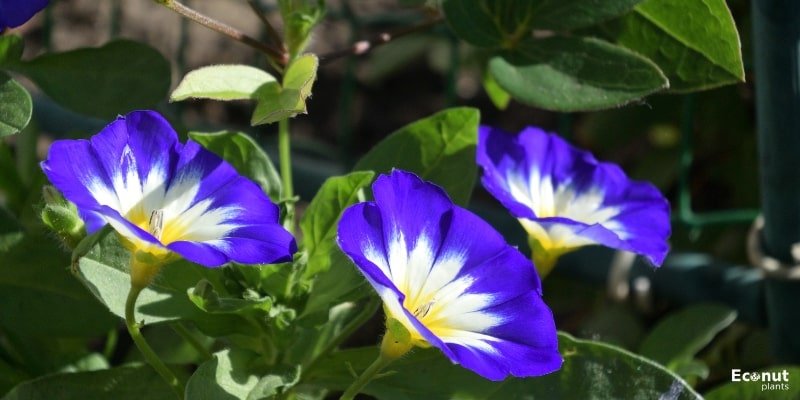
Scientific Name: Evolvulus glomeratus
Plant Type: Perennial
Plant Size: 6 to 12 inches tall
Sun Exposure: Full sun
Dwarf Morning Glory is a dwarf variety of the Morning Glory vine that grows well as a tiny bush or potted plant. The plant retains the parent version’s vine-like stems, which enable the Dwarf Morning Glory’s leaves to get dense and woody.
The flowers resemble widely dispersed trumpet forms, with a diameter of up to two inches. The royal blue colour of the Dwarf Morning Glory blossoms sets them apart from other blue flowering plants and gives your yard a striking blue accent.
Each flower has a gold and white circle in the center, which gives the vivid blue edges even more definition.
6. Blue Cardinal Flower
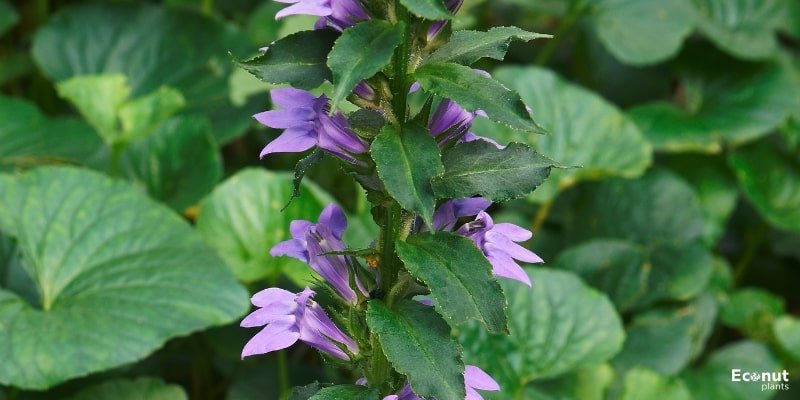
Scientific Name: Lobelia siphilitica
Plant Type: Annual
Plant Size: 3 to 5 inches tall
Sun Exposure: Full sun, partial shade
Not quite a shrub, the Blue Cardinal Flower is another plant with blue blossoms that goes by the names Great Lobelia and Great Blue Lobelia. But when multiple of these plants are grouped in your yard, the Blue Cardinal Flower acquires a deep, woody base. Along with their long, straight stalks supporting the flowers, they resemble a shrub.
Bright blue or violet blooms are present. Along with their lance-shaped, narrow leaves, they grow around the central stem. Typically, the petals of the blooms measure five inches in length. Its distinctive shape is reminiscent of a Snapdragon because the lower three petals reach downward while the upper two curl back.
7. Bellflower

Scientific Name: Campanula carpatica
Plant Type: Perennial
Plant Size: 5 to 7 inches tall
Sun Exposure: Full sun, partial shade
The bellflower resembles many blue-flowering bushes in appearance while not being a shrub in the traditional sense. The bellflower plant resembles a little shrub because of its lush foliage and the numerous thin stems that emerge from the main root system.
The bell-shaped and pale blue or bluey-purple-coloured flowers of the bellflower are easily recognizable. Since they too have a bell-shaped bloom that is blue in colour, the harebell and bluebell flowers are species of the bellflower.
While certain types of bellflowers are invasive and may attempt to take over your yard, others can grow well in a garden or pot. You can help control the plant by pruning off its deadheads.
8. Blue Plumbago

Scientific Name: Plumbago auriculata
Plant Type: Shrub
Plant Size: 20 feet tall
Sun Exposure: Full sun
One of the more expansive blue flowering shrubs, the Blue Plumbago has vine-like branches that saunter sideways through your landscape. A blue plumbago requires more space than a typical shrub as a result.
The blue plumbago often flowers year-round, having a longer blooming time than other flowering plants. The little blossoms cluster together. Each of the individual blossoms is pale blue or bluey-purple in colour, with five petals.
This shrub, especially in colder climates, can be grown in a pot. But you ought to place it in a container big enough for this quickly spreading shrub. Potted blue plumbago will also flourish if you give it careful pruning and provide shelter from the cold throughout the winter months.
9. Blue Rose of Sharon

Scientific Name: Hibiscus syriacus
Plant Type: Shrub
Plant Size: 8 to 12 feet tall
Sun Exposure: Full sun
The Blue Rose of Sharon is a sterile variety of the more common Rose of Sharon that does not yield viable seeds. But this lovely plant gives your yard or garden valuable, lush greenery and fairytale-like blossoms.
Each flower only blooms for one day at a time, with a shorter flowering span from mid-summer to fall. The flowers have a diameter of around four inches and are a light blue colour. These flowers have layers of petals and have a delicate, lace-like appearance.
Being a structural shrub, the Blue Rose of Sharon is excellent as a hedge or border for your yard. Being a deciduous shrub, it will shed its large leaves each autumn.
10. Blue False Indigo

Scientific Name: Baptisia australis
Plant Type: Perennial
Plant Size: 2 to 4 feet tall
Sun Exposure: Full sun, partial sun
The Blue False Indigo has a bushy base composed of huge, dense leaves, despite not being a shrub in the traditional sense. Blue False Indigo, a member of the pea family, displays its tiny blossoms on multiple slender stems. Its juices can sometimes be used in place of true indigo, although they are not the same.
The flowers are a light blue to blue-purple. With three to four primary petals that curl apart, they resemble pea plant blooms in appearance.
Green false asparagus can have new branches that resemble asparagus when they emerge from the ground. But this plant shouldn’t be consumed because it might be poisonous to people, especially small ones.
11. Russian Sage
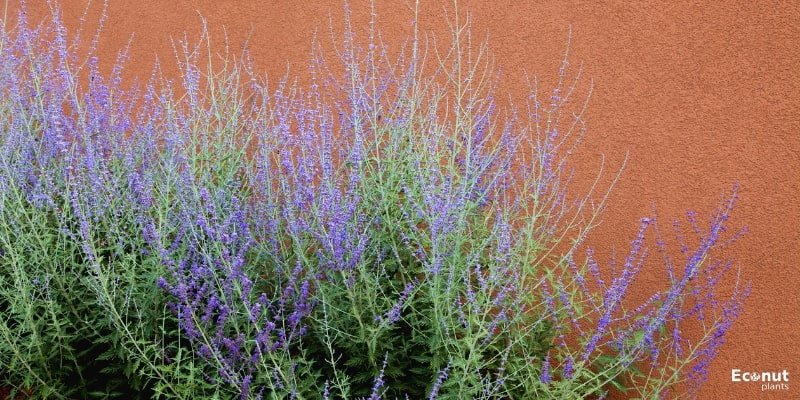
Scientific Name: Perovskia atriplicifolia
Plant Type: Shrub
Plant Size: 3 to 5 feet tall
Sun Exposure: Full sun
This subshrub resembles sage and is a more compact option for yards or gardens. Woody foliage and robust, square-shaped stems dotted with tiny flowers characterize this plant.
Although Russian sage tends to be more purple than blue, it can nevertheless give your yard a similar look. The “Blue Spire” variety of Russian sage, on the other hand, produces flowers with a more royal blue colour.
When broken, the Russian sage releases a scent akin to lavender or other sages. When allowed to spread out, each stem contains a cluster of individual flowers that resemble triangles and appear sparser than their neighbours
12. Spiked Speedwell
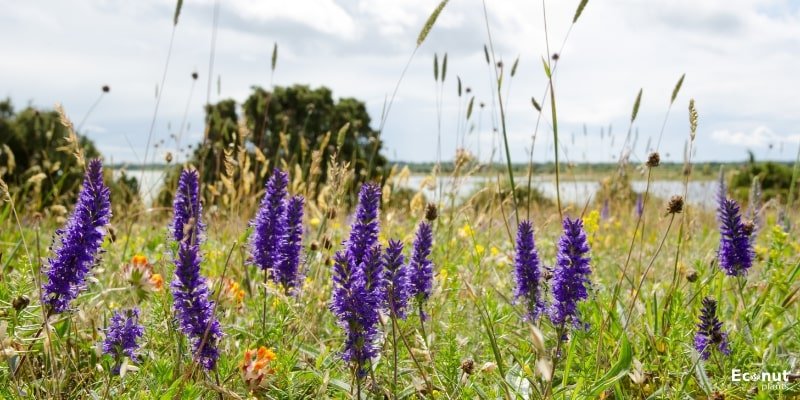
Scientific Name: Veronica spicata
Plant Type: Perennial
Plant Size: 18 to 24 inches tall
Sun Exposure: Full sun
Given its low maintenance requirements, spiked speedwell can be grown anywhere—in your garden, on rocky ground, or even in a container. The spiked speedwell, while not a shrub, will grow dense foliage that can give the impression of one, especially when there are multiple plants.
Spiked Speedwell has tall stems adorned with spiky flower patterns, as the name would imply. The tiny, brilliant blue or bluey-purple flowers are single blooms. The flowers make a bottle-brush arrangement that resembles a lilac shrub when combined.
Despite being non-invasive, spike speedwell grows quickly, so any seeds you plant could result in an unexpected outbreak of the plant.
13. California Lilac
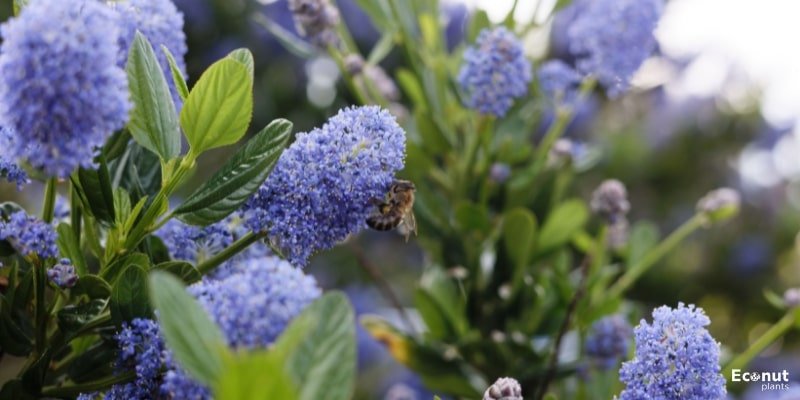
Scientific Name: Ceanothus concha
Plant Type: Shrub
Plant Size: 4 to 6 feet tall
Sun Exposure: Full sun
One of the simplest blue-flowering shrubs to grow is the California lilac, often called soap bush or ceanothus. The shrub can sprout more quickly than you might imagine and doesn’t require much encouragement to flourish.
The California Lilac features clusters of tiny blooms that form bottle brush forms all over the plant, just like any other lilac bush. Each flower has a narrow trumpet-shaped form, and when combined with dozens of other flowers, they create beautiful cone-shaped blossoms.
The blue tones of the California lilac range from deeper blues to softer purple-blue tones. Butterflies, bees, and birds are drawn to it. It can also serve as a partial yard barrier or as a stand-alone shrub or tree.
14. Bluebeard
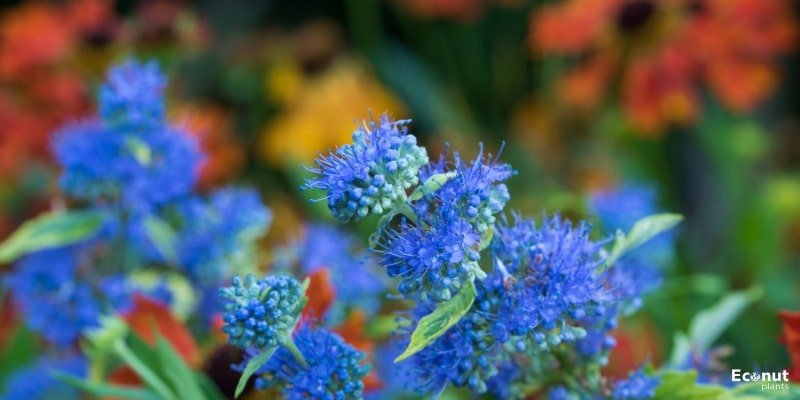
Scientific Name: Caryopteris x clandonensis
Plant Type: Shrub
Plant Size: 2 to 3 feet tall
Sun Exposure: Full sun
The Bluebeard plant, sometimes called Blue Mist or Blue Spirea, has a later flowering season that often lasts from late summer to autumn.
Large, dense leaves provide the plant with a substantial foundation while blooming branches climb above it. The leaves frequently have a light scent that is reminiscent of eucalyptus. The actual flowers are tiny and occasionally white or light blue.
Around the center stem, they form clusters every few inches, with the lowest clumps flowering before the upper ones.
The blossoms resemble thistles as they open up and release long blue whiskers. As summer draws to a close, the Bluebeard plant will draw hummingbirds and butterflies to your yard.
15. Blue Butterfly Bush

Scientific Name: Rotheca myricoides
Plant Type: Shrub
Plant Size: 8 feet tall
Sun Exposure: Full sun, partial shade
You can use this tropical bush as a houseplant or as a mainstay in your garden. It can grow up to eight feet tall, but you can plant the trimmings in a flowerpot and trim them down to the size you choose. It grows nicely as a four-foot-tall shrub as well.
The Blue Butterfly Bush bears small, delicate flowers that assemble into substantial flower bunches. The flowers themselves resemble butterflies in shape and are a soft blue colour. They draw actual bees, butterflies, and occasionally hummingbirds.
The majority of people refer to this shrub as Clerodendrum ugandense, even though its Latin name is Rotheca myricoides. The plant was previously known as Clerodendrum Gardens since it was believed to be a member of the South American Clerodendrum family.
16. Big-Leaf Hydrangea
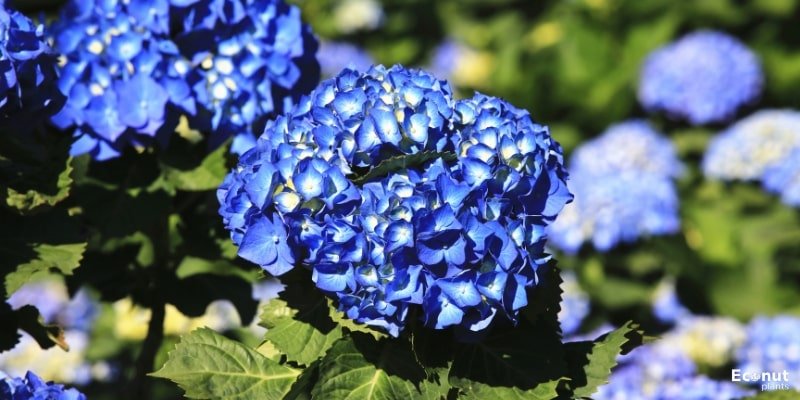
Scientific Name: Hydrangea macrophylla
Plant Type: Shrub
Plant Size: 5 to 6 feet tall
Sun Exposure: Full to partial sun
It’s a popular practice to cultivate hydrangea in your yard or garden because the shrub can reach hedge-like heights. It produces circular clusters of larger blooms from the little flowers that grow during the summer.
The Big-Leaf Hydrangea features broad, plain leaves with serrated edges, as the name would imply. It is simple to grow, but if you prune it too late in the season or if it doesn’t receive enough sun, it might not blossom.
This garden favourite’s blue blooms are brought out by extremely acidic soil, even though hydrangeas also offer pink or white blossoms. Blue flowers are also more common in some hydrangea species. There are shades of blue, from light to deep. A tree that has leaves, the Big-Leaf Hydrangea, will lose its leaves in the autumn and regrow them in the spring.
17. Blue Potato Bush

Scientific Name: Lycianthes rantonnetii
Plant Type: Shrub
Plant Size: 6 feet tall
Sun Exposure: Full sun
This perennial shrub, which goes by the names Paraguay Nightshade and Blue Solanum Shrub, is related to foods such as potatoes, tomatoes, and eggplant. The blue potato bush, in contrast to these species, is toxic and should not be included in your vegetable garden.
The Blue Potato Bush is a lovely addition to a front garden and, depending on how it is pruned, can even serve as a hedge or a tree, even though it cannot assist you in growing your food.
The little blue flowers have a darker star-shaped pattern running the length of the petal within. It can also be used as a potted indoor plant. After the flowers, the Blue Potato Bush will release its deadly red berries; therefore, if you have kids or pets, be sure to keep them away from the plant during this time.
18. Golden Dewdrops

Scientific Name: Duranta erecta
Plant Type: Shrub
Plant Size: 10 to 20 ft. tall
Sun Exposure: Full sun
Golden dewdrops are evergreen shrubs with blue-purple flowers that grow best in full sun in the tropics. The striking landscape shrub can be recognized by its clusters of golden yellow berries, lush green foliage, and violet-blue blooms on arching, vine-like branches. It can be grown as a rounded shrub while being a spreading plant.
Up to 20 feet (6 meters) tall and 10 feet (3 meters) broad, golden dewdrop shrubs can reach their maximum growth. They do well as evergreen tropical hedges, border shrubs, or container plants and they thrive in light shade. Golden dewdrops can be grown as an annual in colder locations, or they can be brought indoors for the winter in a container.
19. Tube Clematis
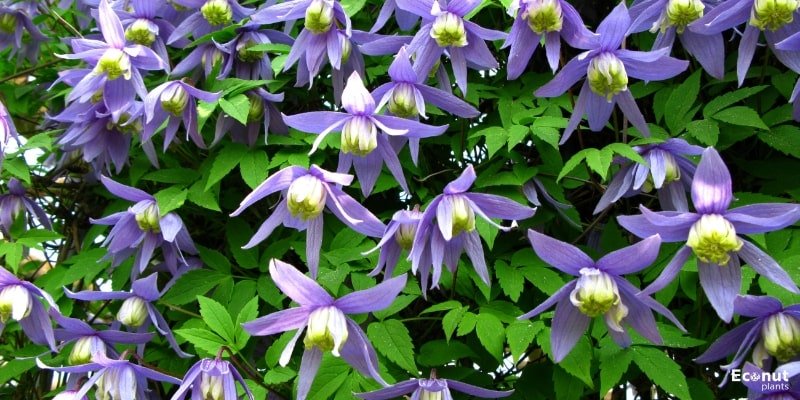
Scientific Name: Clematis heracleifolia
Plant Type: Shrub
Plant Size: 2 to 3 ft. tall and wide
Sun Exposure: Full sun
The mauve bell-shaped flowers of the deciduous subshrub tube clematis bloom all summer long until autumn. Trifoliate leaves, lovely blue blooms with recurved petals, and elegant silky seed heads are the hallmarks of this perennial subshrub. This bushy, blue-flowering, non-climbing shrub can reach a height of three feet (one meter).
Shrubs with tube clematis prefer well-drained soil and full sun over partial shade. It looks wonderful growing as a scrambling bush or as a patio container accent in a sunny perennial border.
20. Rosemary

Scientific Name: Rosmarinus officinalis
Plant Type: Shrub
Plant Size: 2 to 6 ft.
Sun Exposure: Full sun
Rosemary is a multipurpose, evergreen shrub that is prized for its fragrant leaves and tiny, exquisite light blue or dark purple-blue blooms. Grey-green leaves resembling needles, little tubular blooms with two lips, and upright, blooming woody stems are characteristics of rosemary bushes, which thrive in full light.
Rosemary plants have an erect, bushy growth and can reach heights of up to 6 feet (1.8 meters). In addition to being great flowering shrubs for herb gardens, rosemary leaves add a distinctive flavour to stews, soups, and meat dishes. In landscaping, rosemary is frequently used as a low hedge or border plant.
21. Creeping Blue Blossom
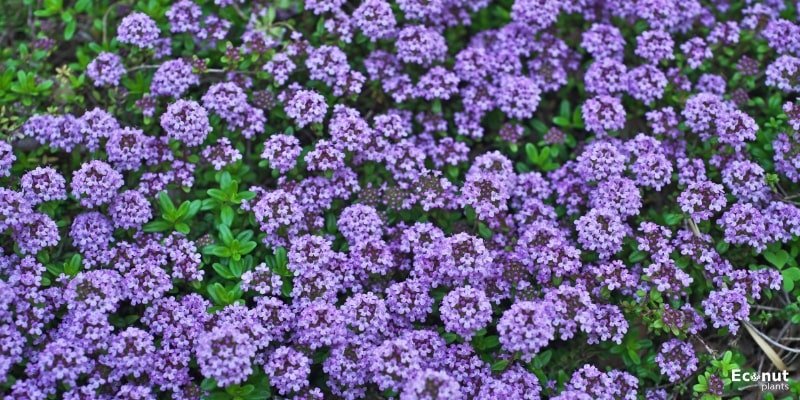
Scientific Name: Ceanothus thyrsiflorus var. repens
Plant Type: Shrub
Plant Size: 2 to 3 ft. tall
Sun Exposure: Full sun or partial shade
Clusters of vivid, fragrant sky-blue flowers are produced by the low-growing evergreen shrub known as the creeping blue blossom. The creeping shrub grows best on soils that are dry to medium-wet and in full sun. The dwarf shrub reaches a maximum height of 3 feet (1 meter) and a maximum width of 10 feet (3 meters).
The best ground cover for blue-flowering ground cover and erosion control is drought-tolerant creeping blue blossom. The spreading shrub can also be planted as a border along a wall, as a foundation planting, or to draw butterflies.
Additionally, it helps stabilize the land on slopes and banks. This adaptable shrub is perfect for giving your yard some blue hue and texture.
Conclusion
The good news is that there are many options available if you’re looking for a blue-blooming shrub for your yard or garden. True, some of these shrubs have a violet tint, but up close, many of them have a blue tint.
If you would rather not commit to an actual shrub, you can choose blue-flowering plants that resemble shrubs. Whatever you choose, there are lots of blue flower bushes that can turn your house or outside area into a stunning work of art!

